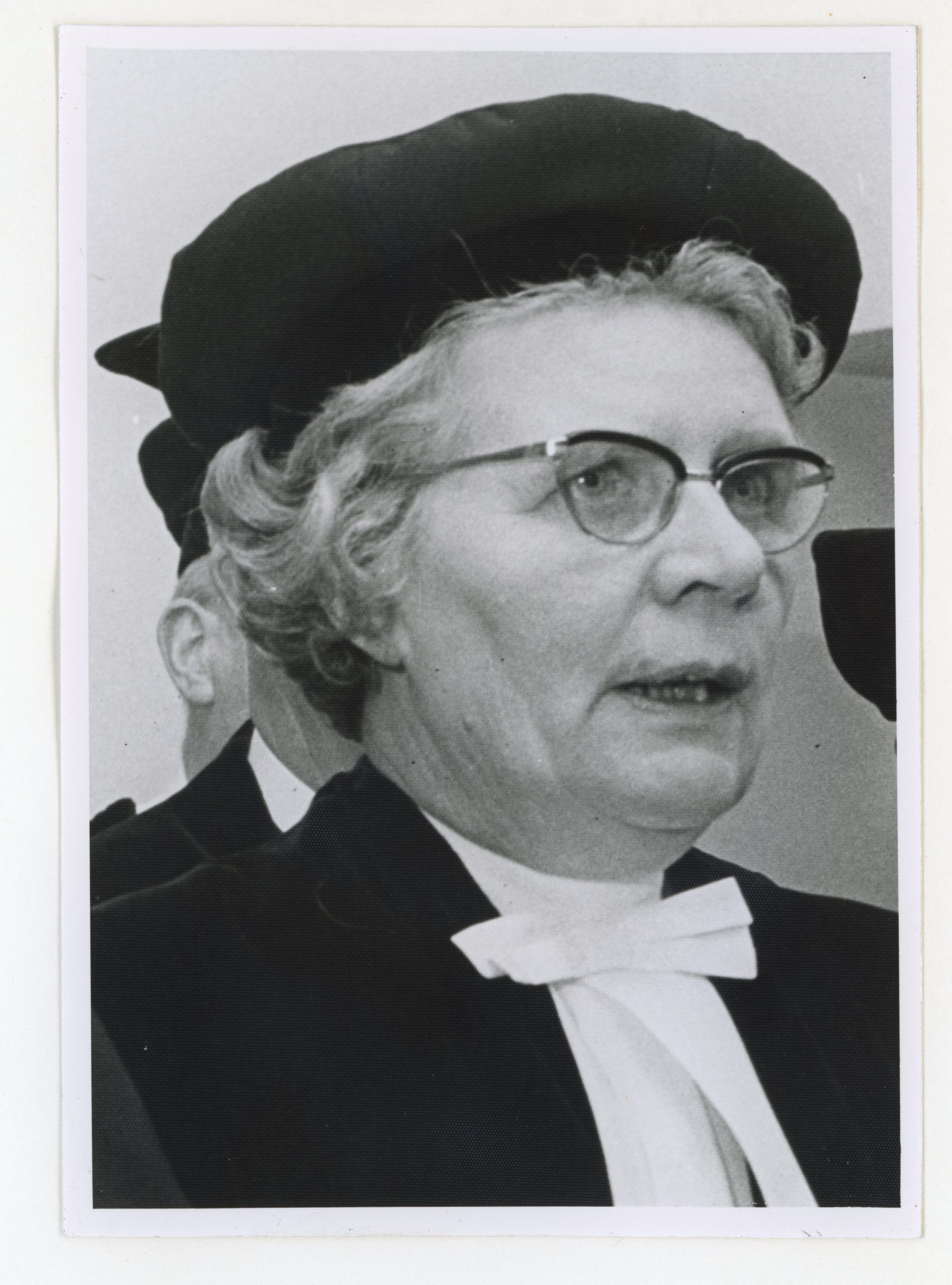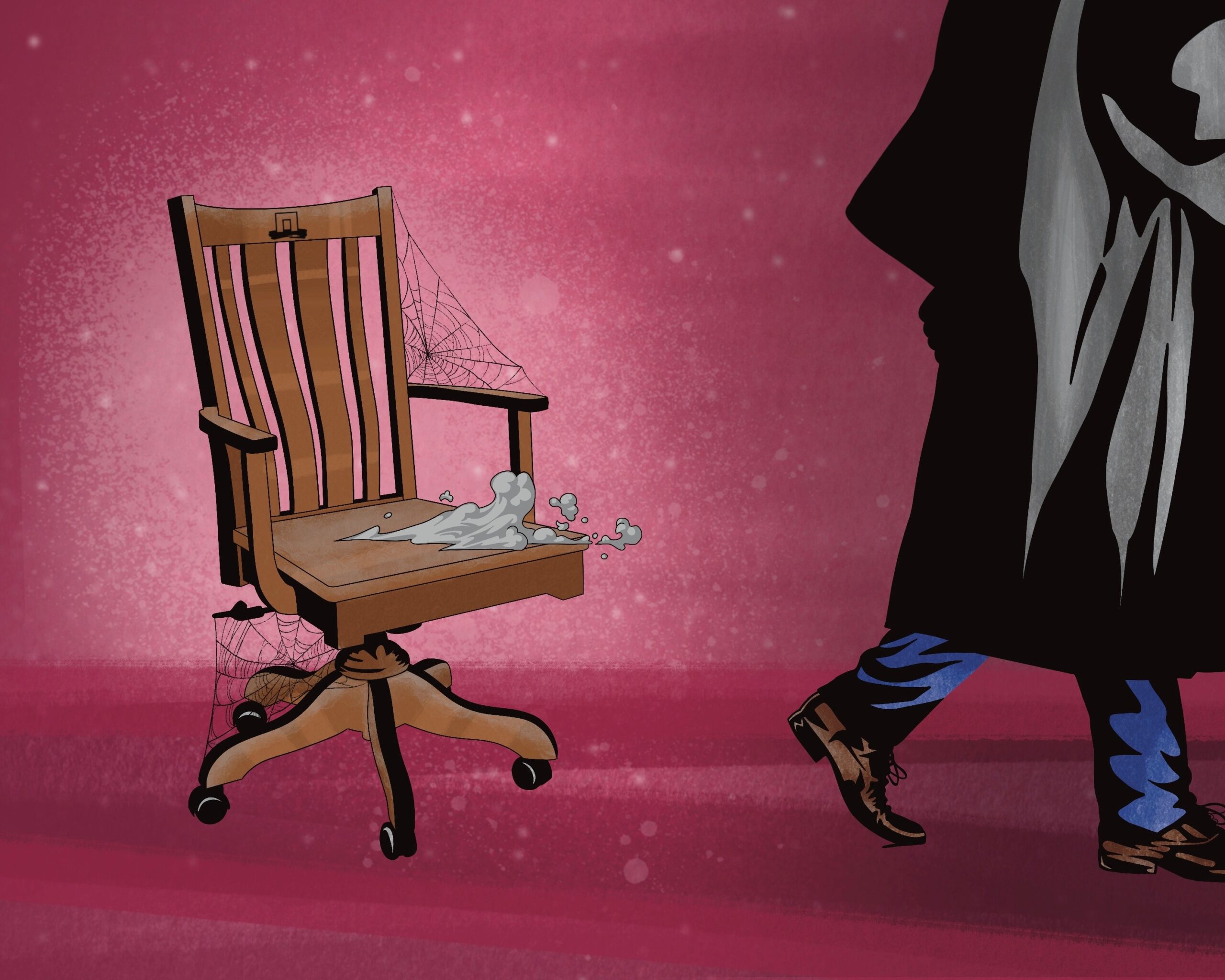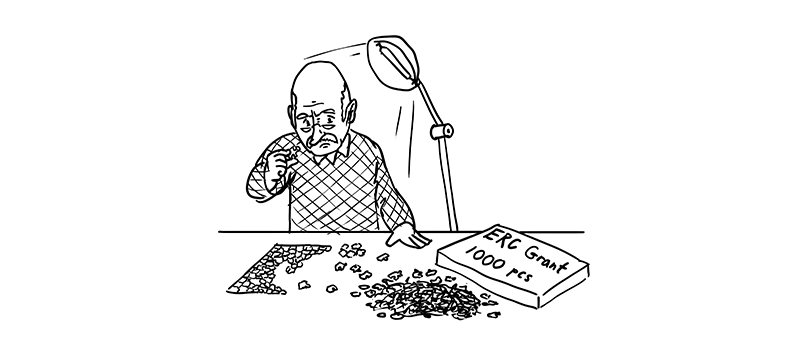There is no portrait of Mien Visser, Wageningen’s first female professor, in the Omnia Hall of Fame. She never had her portrait painted. But as Resource discovered already, there is a picture of her. This is her story.
On International Women’s Day, the President of the Executive Board Sjoukje Heimovaara hung up a mirror on the Omnia ‘wall of men’. It was a light-hearted action aimed at highlighting the importance of inclusiveness at WUR. Diversity is sorely lacking in the Hall of Fame with its professors and rectors. The mirror symbolizes self-reflection. Heimovaara could have made a start with that inclusiveness by hanging up Mien Visser’s image. Because there is one.
As of last autumn, WUR’s Art and Heritage Committee has had a little painting in its storage room. Well, actually it’s a photo of Mien Visser with a painted border. It is not known who made the artwork. On the right edge is written ‘Labor sine nomine X III MCMLXIX’, i.e. unnamed work, 10 March 1969. The text and date refer to a milestone in WUR’s history,
as this was the date when Mien Visser became the first woman to give the Founders’ Day Address, 50 years after the Agricultural College was founded. Of course, her address was about her discipline, domestic science. The unpaid work of the housewife, nameless work. Certainly in her day, it was mainly the woman’s task. And that needed to change. According to Visser, nameless work ‘should be everyone’s work in our modern society, regardless of whether we are men or women, married or unmarried.’ That was the final sentence in her address. We are now more than 50 years further but even in 2023 an equitable division of housework tasks is still a pipe dream in many Dutch homes.
Daughter
The story of how Clara Wilhelmina Visser, born in Amsterdam on 8 June 1907, became a professor of Rural Home Economics is rather interesting. She grew up in Amsterdam and studied pharmacy after finishing secondary school. Her life changed after she married Pieter Leonard Willinge Prins in 1930. He had studied in Wageningen and wanted to be a farmer. The couple moved to Anloo in Drenthe, where they rented Schipborg farm on reclaimed land. ‘That’s how my mother ended up in the countryside,’ says her daughter Clara (Ernestina) van den Ban, now aged 91. She grew up on the farm but has spent the past 40 years living just down the road from De Dreijen in Wageningen, in the house her mother had built when she became a professor.
Her mother’s life story can be found in the Dutch Wikipedia and the Huygens Institute’s Digital Lexicon of Dutch Women. Visser worked for a pharmacy in Groningen for a while but soon became involved in local organizations that gave home economics advice to rural households. After the war, her husband became mayor of Anloo. Visser herself became president of the Dutch Association of Rural Women in 1948. She was also a member (Labour Party) of the Drenthe provincial council from 1949. Her husband Prins died during a drag hunt in 1950.
Having your portrait painted was no longer the rule by then
By this point, Visser was involved as the rural association president in investigations into the possibility of starting a rural home economics degree course in Wageningen. The Wageningen professor Ede Brouwer had been to America, where he had learned about Home Economics as a subject. This led to a study trip to America in the summer of 1951, which included Visser as the association president. That same year, she was nominated for the position of professor of the new degree programme at the Agricultural College, a position she held from 1952 to 1977.
Unexpected
And no, she never had her portrait painted, says her daughter Clara. ‘That was no longer the rule by then.’ She did not even get a formal farewell, which could have been an occasion for a portrait — she died unexpectedly in spring 1977. One year later, the book Huishoudkunde in Nederland (Home Economics in the Netherlands), a collection of essays by her students, was published as a posthumous farewell gift. But Clara does have some fine photos of her mother that Resource has been allowed to use. She has a subscription that lets her keep up to date with campus affairs. Like her father, Clara van den Ban studied in Wageningen. She started in 1950, before her mother became a professor, and graduated in 1957 as one of the first in the new degree subject. Mien’s granddaughter, Clara’s daughter Greetje, also studied at Wageningen: Human Nutrition rather than Home Economics though.
But those three generations of Wageningen students (father-daughter-daughter) are not the end of the story. Mien Visser remarried in 1959; her new husband was fellow professor Willem Frederik Eijsvogel (Road and Hydraulic Engineering). Her daughter Clara had just married Jan van den Ban, an Agricultural Plant Breeding student. In 1983, he became a professor of Land Development at Wageningen. His brother Anne van den Ban (of Anne van den Ban Fund fame) had been a professor of Rural Extension for nearly 20 years at that point. And to complete the picture, Mien’s one year younger sister Lies Visser also became a professor. In 1947, she became the first female professor of Dutch History in Groningen.
Art Committee
Clara van den Ban never wanted an academic career. After graduating, she spent a year in teacher training in Zetten. ‘Then we had children and I did a lot of committee work in the voluntary sector.’ Her committee activities date from her student days. The book Vrouwen, Wageningen en de Wereld (Women, Wageningen and the World) has a photo from 1952 of her congratulating her mother on her inaugural address. She was president of the women’s students club WVSV.
Clara van den Ban is aware of the artwork the Art Committee has. She has a copy in her office, given to her at the time by the person who made the original, although she no longer remembers who that was. She is, however, certain the artwork was not made back in 1969 at the time of the Anniversary Address. ‘It dates from when the department moved from Dreijenborch to Leeuwenborch.’ That was in 2007. Until recently, the original version hung there in a professor’s office.

 Mien Visser. Own photo
Mien Visser. Own photo 

